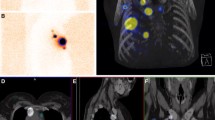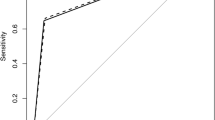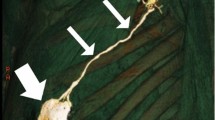Abstract
Background
The purpose of this study was to describe the preoperative diagnosis of the axillary arch with multidetector row computed tomography (MDCT) in patients who underwent sentinel lymph node (SLN) biopsy. In addition, we investigated anatomical problems of SLN biopsy in the cases that diagnosed this anomaly.
Methods
From 2003 to 2008, combined procedures with blue dye SLN biopsy and MDCT-assisted axillary node sampling were performed in 550 clinically axilla-negative patients with primary operable breast cancer. We use MDCT for not only the diagnosis of the axillary arch, but also the planning and navigation of SLN biopsy.
Results
The axillary arches were preoperatively diagnosed with MDCT in 59 patients (10.8%) as follows: a single ordinary axillary arch (n = 44), another anomalous muscle besides the ordinary axillary arch (n = 13), and other rare axillary arches (n = 2). The SLN identification failure rate was 1.8% (9/491) for patients without the axillary arch and 5.1% (3/59) for patients with the axillary arch (chi-square test, P = 0.11). Three patients with an axillary arch in whom a SLN could not be identified were observed in 13 patients who had another anomalous muscle besides the ordinary axillary arch (3/13, 23.1%). In the examination of 56 patients with an axillary arch in whom a SLN was identified, variations of the SLN location and/or anomalous muscles covering a SLN were observed in 16 patients (28.5%).
Conclusions
MDCT is useful for a diagnosis of the axillary arch. The axillary arch should be kept in mind during SLN biopsy because this anomaly would be related to anatomical variations that affect SLN biopsy.



Similar content being viewed by others
References
Daniels IR, della Rovere GQ. The axillary arch of Langer-the most common muscular variation in the axilla. Breast Cancer Res Treat. 2000;59:77–80.
Turgut HB, Peker T, Gülekon N, Anil A, Karaköse M. Axillopectoral muscle (Langer’s muscle). Clin Anat. 2005;18:220–3.
Miguel M, Llusá M, Ortiz JC, Porta N, Lorente M, Götzens V. The axillopectoral muscle (of Langer): report of three cases. Surg Radiol Anat. 2001;23:341–3.
Bonastre V, Rodríguez-Niedenführ M, Choi D, Sañudo JR. Coexistence of a pectoralis quartus muscle and an unusual axillary arch: case report and review. Clin Anat. 2002;15:366–70.
Besana-Ciani I, Greenall MJ. Langer’s axillary arch: anatomy, embryological features and surgical implications. Surgeon. 2005;3:325–7.
Keshtgar MR, Saunders C, Ell PJ, Baum M. Langer’s axillary arch in association with sentinel lymph node. Breast. 1999;8:152–3.
Chêne G, Le Bouëdec G, Dauplat J. Arch and sentinel: surgical technique of sentinel node biopsy with the axillopectoral muscle. Gynecol Obstet Fertil. 2007;35:25–9. (in French with English abstract).
Suzuma T, Sakurai T, Yoshimura G, Umemura T, Shimizu Y, Yang QF, et al. Magnetic resonance axillography for preoperative diagnosis of the axillopectoral muscle (Langer’s axillary arch): a case report. Breast Cancer. 2003;10:281–3.
Hollinshead WH. Anatomy for Surgeons: the back and limbs. 3rd ed. Philadelphia: Harper and Row; 1982. pp. 280–1.
Kasai T, Chiba S. True nature of the muscular arch of the axilla and its nerve supply. Kaibogaku Zasshi. 1977;52:309–36. (in Japanese with English abstract).
Takafuji T, Igarashi J, Kanbayashi T, Yokoyama T, Moriya A, Azuma S, et al. The muscular arch of the axilla and its nerve supply in Japanese adults. Kaibogaku Zasshi. 1991;66:511–23. (in Japanese with English abstract).
Sawada M, Ishibashi Y, Suzuki T, Chiba S. Case reports on the pectoralis quartus and the pectoralis intermedius muscles. Kaibogaku Zasshi. 1991;66:99–105. (in Japanese with English abstract).
Miyauchi R. A very rare variation of the latissimus dorsi muscle: a case with accessory insertion of the latissimus dorsi muscle into the first rib and into the pectoralis minor muscle. Okajimas Folia Anat Jpn. 1982;58:521–34.
Author information
Authors and Affiliations
Corresponding author
About this article
Cite this article
Ando, J., Kitamura, T., Kuroki, Y. et al. Preoperative diagnosis of the axillary arch with multidetector row computed tomography and the axillary arch in association with anatomical problems of sentinel lymph node biopsy. Breast Cancer 17, 3–8 (2010). https://doi.org/10.1007/s12282-009-0138-4
Received:
Accepted:
Published:
Issue Date:
DOI: https://doi.org/10.1007/s12282-009-0138-4




